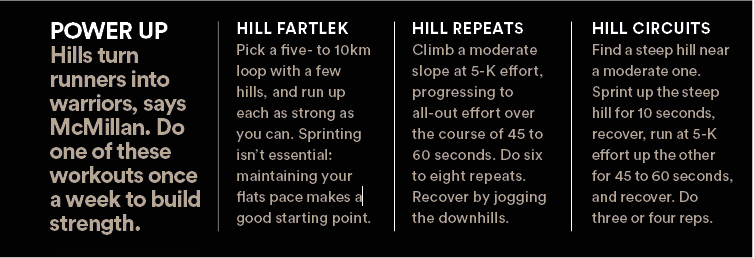7 Simple Ways To Be A Stronger Runner
Train to become more efficient, and running far or fast will feel easier.
Train to become more efficient, and running far or fast will feel easier. – By Kelly Bastone

If you want to run further and faster with less effort, you must perform like a Prius, not a Hummer. Like cars, runners exhibit a range of fuel economies, only they draw on oxygen rather than petrol. “We’re not technically burning oxygen, but we need it as part of the energy-liberating process,” says coach Greg McMillan. By training your body to sip instead of gulp oxygen, you can log longer runs or cover a typical distance with greater speed.
“Economical runners enjoy more wiggle room before fatigue sets in,” says McMillan. They burn through muscle glycogen stores more slowly, so their tanks can power them over greater distances. But becoming more economical also makes you speedier over shorter distances, because burning less fuel leaves more energy for explosive power. It may even decrease injury risk by distributing work across more muscle fibres, says Dr Tara Whiton, an exercise physiologist and running coach at The Sustainable Athlete.
And running economy is very trainable: “Our bodies are always trying to find the least taxing way to do things,” says McMillan.
Try one of these four strategies.
RUN MORE
Research has shown that runners who run high mileage (more than 110 kilometres per week) tend to be more economical. But you don’t have to log elite-level volume to reap benefits: even modest mileage increases recruit more capillaries and mitochondria (which help oxygen get to and fuel working muscles). To increase your volume without spiking your injury risk, try adding five more minutes to each run, or upping your frequency (perhaps by changing a rest day to an easy run). Don’t worry about intensity: “Most of your efficiency comes from adding more easy-effort kilometres,” says exercise physiologist and running coach Patti Finke. That’s because repetition trains your brain to fire your muscles in the best, most expedient sequence.
PLAY WITH PACE
“When you add in some fast running, your body says, ‘I’d better figure out how to do this with less effort,’” says McMillan. He recommends that runners adjust their pace by feel rather than by their watches, because numbers aren’t as helpful for teaching runners their effort-to-fatigue ratio. “This pays dividends over time,” says McMillan, “because if the weather is bad or you just feel ‘off’ one day, you can rely on feel to still get in a positive workout.” Eight to 10 times over every run you log, pick up the pace for 30 seconds to a minute, “just to the point that you notice you’re breathing faster,” says McMillan, then slow down and let your breathing recover. Once that’s routine, experiment with a race pace: if you’re aiming for a 5-K, incorporate short bursts (from 30 seconds to several minutes) of your goal pace into your runs, totaling 20 minutes per week. Experienced marathoners should do longer, continuous sessions (like parts of their weekly long runs) at race pace, totalling one to two hours per week.
BUILD POWER
“There’s a lot of research showing that high-intensity strength-training can improve running economy,” says Whiton. She favours squats, lunges, and deadlifts, while carrying enough weight so that your last rep leaves you exhausted. Try two to three sets of six. Or try skipping: classic, two-footed hops are “a great exercise for running economy and injury prevention, because they exaggerate the one-footed hopping you do while running,” says McMillan. Do at least one strength session per week; schedule it several days before your major running workouts (or immediately afterwards, on the same day).
ADD HILLS
Hills recruit more muscle fibres than flat terrain does, so making them part of your routine is a surefire way to build running economy. You can do reps on one hill (charging uphill and jogging back down), or you can just work hills into your regular runs. “During the base-building phase, run hills at a slow pace, every other week,” says Finke. Once you’ve achieved base fitness, up the ante with McMillan’s economy booster: do one hill-centric run every week for six weeks. (See ‘Power Up’, below.) “Your strategy doesn’t have to be precise,” he says. “The steeper the hill and the more energy you throw at it, the better.” Recover for 24 to 48 hours before your next hard run. Read more on training hills here.
READ MORE ON: get stronger hills strength-training training





